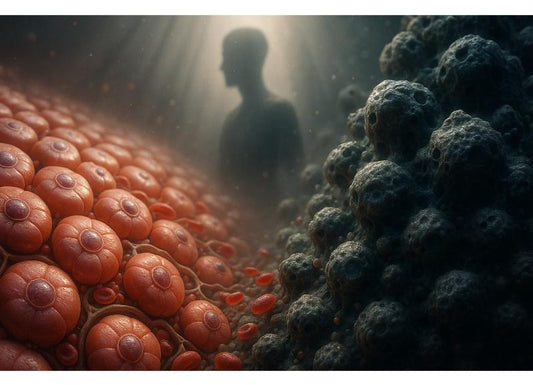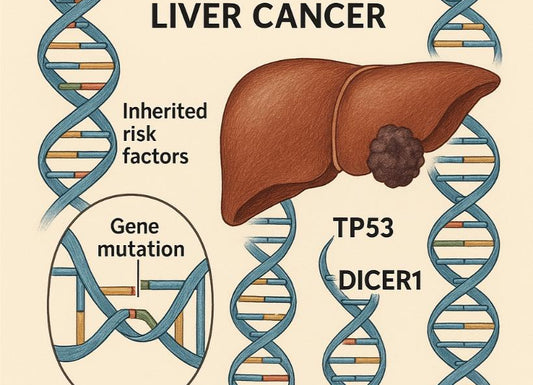What Cancers Cause Elevated Liver Enzymes? Causes, Patterns, and When to Worry
 Written By
Jaclyn P. Leyson-Azuela, RMT, MD, MPH
Written By
Jaclyn P. Leyson-Azuela, RMT, MD, MPH

When blood tests show elevated liver enzymes, it’s natural to worry especially when you’re concerned about cancer. So, what cancers cause elevated liver enzymes to begin with? Several cancers can raise liver enzymes, particularly those that begin in the liver or spread to it. This includes hepatocellular carcinoma (HCC, which is the main form of primary liver cancer) and cancers such as colorectal, breast, lung, pancreatic, stomach, esophageal, melanoma, and neuroendocrine tumors that often spread (metastasize) to the liver.
Key Insights
-
Many common cancers spread to the liver and can raise enzymes, especially colorectal, breast, lung, pancreatic, stomach, esophageal, melanoma, and neuroendocrine tumors.
-
ALT and AST suggest hepatocellular injury, ALP and GGT suggest cholestasis, and bilirubin patterns point toward obstruction or parenchymal disease.
-
Ultrasound comes first for cholestasis, MRCP or contrast CT often follow, and biopsy is considered when results remain inconclusive.
-
Confirm abnormal labs but avoid serial repeats without workup, and refer when thresholds are met or symptoms or imaging are concerning.
-
Urine strips detect bilirubin and urobilinogen, not enzymes, and positive results should lead to formal evaluation.
What Do Liver Enzyme Elevations Mean?
Elevations in ALT, AST, ALP, GGT, and bilirubin usually reflect one of two things:
-
Injury to the liver cells, which may be caused by cancer in the liver, acute conditions affecting the liver, and genetic problems of the liver, among other things
-
Cholestasis, which affects bile flow blockage from tumor compression of bile ducts or stones
Understanding which pattern your lab results point to can help your clinician decide when to order further testing like imaging, repeat tests, or refer you to a specialist like a hepatologist or oncologist
What Does It Mean When Cancer Raises Liver Enzymes?
You may notice terms such as “hepatocellular pattern” or “cholestatic pattern” on your lab report. These describe how enzyme changes reflect what is actually happening in the liver.
-
Hepatocellular pattern: ALT and AST are higher than ALP. These values point toward direct liver cell injury. It is often seen in liver cancers, such as hepatocellular carcinoma.
-
Cholestatic pattern: ALP and GGT are higher than ALT and AST. These values suggest that there is bile duct obstruction or pressure, often from metastatic tumors.
However, your doctor will interpret your results accordingly. This is often done alongside other tests like imaging studies and a comprehensive medical history. A complete picture of the condition is then arrived at based on different insights and identifies whether liver damage stems from cancer, medications, infection, or entirely another cause.

Do Primary Liver Cancers Affect Enzymes?
Yes. HCC and intrahepatic cholangiocarcinoma start in the liver and injure liver cells directly. These cancers typically elevate the liver enzymes, such as the AST or ALT, and may raise ALP and bilirubin as the disease advances.
Patients with HCC may notice the following symptoms early:
-
Fatigue
-
Jaundice
-
Right upper quadrant abdominal pain
-
Weight loss (unintentional)
-
Abdominal swelling due to accumulation of fluid
In early stages, enzyme changes may be mild or non-specific, so people at risk, such as those with chronic hepatitis B or C, or cirrhosis, benefit from regular ultrasound and AFP monitoring to detect cancer before it spreads.
Which Metastatic Cancers Commonly Elevate Liver Enzymes?
Many cancers spread to the liver because of its rich blood flow and filtering role. Among the most common are:
-
Colorectal cancer: This often metastasizes to the liver through the portal vein, producing cholestatic patterns (high ALP, GGT) when bile ducts are compressed.
-
Breast cancer: Liver metastases can appear months before detection on scans. Early clues include rising ALP, GGT, AST, LDH, and bilirubin with decreasing albumin levels.
-
Lung cancer: This may cause elevated ALP and GGT when there are secondary lesions that develop in the liver.
-
Pancreatic cancer: This type of metastasis may likely cause obstructive cholestasis, with striking ALP and GGT increases when tumors block the distal bile duct.
-
Gastric and esophageal cancers: These types of tumors often seed the liver in advanced stages; ALP elevation can mirror tumor burden
-
Melanoma: This is known for widespread metastasis, including to the liver, unexplained cholestatic enzymes in a patient with melanoma always warrant imaging.
How Do Blood Cancers Influence Liver Enzymes?
Cancers of the blood, such as lymphoma or leukemia, can infiltrate liver tissue. This tends to cause mixed or cholestatic enzyme patterns rather than isolated ALT/AST elevation.
If enzyme elevations accompany fever, night sweats, weight loss, or lymph node enlargement, your doctor may consider a hematologic malignancy and order imaging, specialized blood work, or liver biopsy to confirm.
What Are the Warning Signs When Liver Enzymes Are High From Cancer?
Early stages of cancer may not show any symptoms at all. At most, it could show some non-specific symptoms, which can easily be mistaken for another disease.
Which Symptoms Signal Liver Cancer or Metastases?
Some people have no early symptoms. But as disease progresses, signs may include:
-
Jaundice (yellowing of skin or eyes)
-
Right upper abdominal pain or fullness
-
Abdominal swelling or ascites
-
Early satiety or loss of appetite
-
Itching (pruritus)
-
Unexplained weight loss or fatigue
If these symptoms appear alongside abnormal enzymes, clinicians move quickly to imaging and specialist referral.
Are There Specific Clues for Cholestasis vs. Hepatocellular Injury?
-
Cholestasis adds itching, dark urine, pale stools, and jaundice. This suggests bile blockage and conjugated hyperbilirubinemia.
-
Hepatocellular injury tends to present with abdominal pain, nausea, and systemic symptoms as liver cells are damaged directly.
How Do Doctors Test and Interpret High Liver Enzymes?
Your doctor will request tests and once the results are out will create an appointment to discuss these with you.
What Do ALT and AST Show?
ALT (alanine aminotransferase) and AST (aspartate aminotransferase) rise when liver cells are injured. When these values are high relative to ALP, the pattern points to a problem within the liver cells themselves, not in bile flow.
What Do ALP and GGT Indicate?
ALP (alkaline phosphatase) and GGT (gamma-glutamyl transferase) reflect cholestasis, particularly when bile can’t flow properly. When ALP and GGT climb out of proportion to ALT and AST, obstruction is suspected.
Bilirubin levels help confirm whether the blockage involves conjugated (direct) bilirubin, which supports a mechanical or cholestatic cause.
How Is Imaging Used?
For a cholestatic pattern, abdominal ultrasound is the first step. It can show dilated bile ducts, gallstones, or liver masses.
If the ultrasound suggests obstruction or masses, doctors may order MRCP (magnetic resonance cholangiopancreatography) or contrast-enhanced CT to map the bile ducts and liver architecture in detail.
When imaging and lab results are inconclusive, and enzyme elevations persist beyond six months or exceed two times the upper limit of normal, a liver biopsy or advanced imaging helps establish the diagnosis and guide treatment.
How Often Should Tests Be Repeated?
Guidelines emphasize confirming abnormal results with repeat labs while starting a structured evaluation rather than repeatedly rechecking without action.
However, if values remain persistently abnormal or worsen, further testing may be necessary, which could include:
-
Serology
-
Imaging
-
Biopsy
These further tests are warranted to uncover the underlying cause.
When Should You Worry About High Liver Enzymes?

As mentioned earlier, there are a lot of liver conditions that will result in an increase in liver enzymes. These conditions need not be cancer or metastasis from a primary source. However, there are instances when there is a high-index of suspicion, when high liver enzymes could signal distress.
Which Values Are Concerning for Cancer?
A cholestatic threshold of ALP > 1.5× ULN and GGT > 3× ULN indicates significant cholestasis and should prompt imaging and specialist evaluation, especially with rising bilirubin or symptoms of obstruction.
However, absolute numbers don’t tell the whole story. The pattern and trend matter more. A steady rise in ALP and GGT, or persistent abnormal results after excluding common causes like medications or fatty liver, deserves further investigation for possible malignancy.
When Should You See a Specialist?
Referral to hepatology or oncology is appropriate when:
-
Enzyme abnormalities persist beyond a few weeks
-
Cholestatic thresholds are reached
-
Imaging reveals a mass or obstruction
-
Red-flag symptoms appear (jaundice, weight loss, and abdominal pain that are severe)
If first-line tests are inconclusive, or advanced imaging or biopsy is being considered, specialist input helps determine the safest and most accurate next step.
Can At-Home Urine Test Strips Detect Liver Problems?
At-home urine test strips are now becoming increasingly popular. It may even help detect liver problems.
What Can They Actually Measure?

Over-the-counter urine strips can detect bilirubin and urobilinogen, substances linked to bile metabolism. A positive bilirubin result suggests conjugated hyperbilirubinemia, which is a signal of possible liver disease or bile duct obstruction.
However, these strips cannot measure liver enzymes like ALT, AST, ALP, or GGT. Their accuracy varies, and results can be influenced by light exposure or urine concentration. They should be viewed as screening tools, not diagnostic tests.
When Is Home Testing Useful?
At-home testing can be useful if you notice dark urine, pale stools, itching, or jaundice and want a quick check before seeing your doctor.
If the strip is positive for bilirubin, or if you have ongoing symptoms or known cancer risk factors, schedule formal testing promptly. Only blood work and imaging can determine whether liver enzyme elevations are due to cancer, infection, or another condition.
How Do Doctors Decide Which Imaging to Order First?
Most clinicians follow structured algorithms such as the ACR Appropriateness Criteria for abnormal liver chemistries.
-
For cholestatic patterns: Ultrasound is done first
-
If non-conclusive: MRCP or contrast CT is done next
-
If diagnosis is still unclear or suspicion persists (meaning the condition cannot be ruled out yet), the next step is to do biopsy or MRI with contrast
These steps balance diagnostic accuracy with safety, cost, and invasiveness, ensuring that imaging follows a logical path rather than guesswork.
What Steps Should You Take if Your Liver Enzymes Stay High?
These are simple things you can do to avoid anxiety and panic especially when you find out that your liver enzymes stay high:
-
Confirm that the results are indeed abnormal. Sometimes, laboratory tests fluctuate and so repeating them after a short period of time may confirm its persistence.
-
Review your medications or supplements. Many conditions when liver enzymes increase are caused by non-cancer reasons. It could be a result of unintentional acetaminophen overdose, use of statins for dyslipidemia, or herbal products (particularly when they are not pure).
-
Check for other benign causes like infections or autoimmune diseases. These are more common than primary or metastatic cancers, particularly in individuals who have low risk of developing one. Viral hepatitis, autoimmune hepatitis, and even fatty liver disease are common mimickers.
-
Request imaging if patterns suggest obstruction. Getting an ultrasound done can clarify whether your bile ducts are obstructed or the liver tissue itself is affected.
-
Ask for specialist referral if enzymes remain elevated or cancer risk factors are present.
-
Track trends over time. Your clinician interprets patterns, whether hepatocellular or cholestatic, to guide diagnosis and management.
Persistent or progressive changes, especially when coupled with symptoms like jaundice or weight loss, always merit timely investigation.
What Is the Connection Between Cancer, Bile Flow, and Enzyme Patterns?

Cancer can influence liver chemistry through multiple mechanisms:
-
Direct infiltration: Tumor cells invade liver tissue, breaking down hepatocytes and releasing ALT and AST.
-
Biliary compression: Masses or metastases press on bile ducts, increasing ALP and GGT.
-
Inflammation and immune response: Tumor-related inflammation or paraneoplastic syndromes alter enzyme activity.
-
Therapy-related injury: Chemotherapy, immunotherapy, or targeted agents can elevate enzymes even in the absence of metastasis.
Understanding these pathways allows doctors to distinguish whether enzyme changes are due to cancer progression, treatment effects, or unrelated conditions.
How Do Liver Enzyme Patterns Guide Cancer Diagnosis and Treatment?
Clinicians often use enzyme patterns to determine next steps:
-
Predominantly ALT/AST elevation: look for viral hepatitis, fatty liver, or hepatocellular carcinoma.
-
Predominantly ALP/GGT elevation: check for bile duct obstruction, metastases, or cholangiocarcinoma.
-
Mixed pattern: may point to infiltrative disease such as lymphoma or multifocal metastases.
These patterns, combined with imaging results, tumor markers, and patient history, shape decisions about biopsy, surgery, or systemic therapy.
When Should You Move Beyond “Watchful Waiting”?
Many mild enzyme abnormalities are rechecked without further action. However, current guidance discourages prolonged “wait and see” when clear triggers for evaluation exist.
Most increased liver enzymes return to normal within 2-4 weeks but if it does not, particularly with cholestatic patterns or cancer risk factors, it’s safer to proceed with imaging and referral rather than repeat testing alone. Early evaluation leads to earlier detection, better prognosis, and peace of mind.
Can Elevated Enzymes Predict Cancer Progression or Prognosis?
In metastatic disease, enzyme trends sometimes mirror tumor behavior. For instance:
-
Rising ALP and GGT may signal advancing cholestasis or increased tumor burden.
-
Increasing AST and bilirubin with falling albumin can indicate worsening liver function.
-
In breast cancer, serial liver enzyme tracking helps monitor response to treatment and detect relapse early.
Still, enzymes alone cannot predict outcomes. They must be interpreted within the broader clinical picture, including imaging and symptoms.
Related Resources
Can Elevated Liver Enzymes Be Cancer? Exploring the Link
When to Stop Statin Elevated Liver Enzyme? Key Decision Points
Quick Summary Box
-
Cancers raise liver enzymes by injuring liver cells or blocking bile flow.
-
Primary liver cancers (like HCC) and metastatic cancers (colorectal, breast, lung, pancreatic, stomach, esophageal, melanoma) are the leading culprits
-
ALT and AST → hepatocellular injury; ALP and GGT → cholestasis; bilirubin adds diagnostic context.
-
Ultrasound is the first imaging step; MRCP or CT follows if obstruction or metastases are suspected.
-
Confirm abnormal labs but don’t rely on serial rechecks alone; start a focused evaluation early.
-
Urine test strips detect bilirubin but cannot measure enzymes or diagnose cancer; positive results should prompt formal testing.
References
American Cancer Society. (2019, April 1). Signs and Symptoms of Liver Cancer. Www.cancer.org. https://www.cancer.org/cancer/types/liver-cancer/detection-diagnosis-staging/signs-symptoms.html
Asafo-Agyei, K. O., & Samant, H. (2023). Hepatocellular carcinoma. PubMed; StatPearls Publishing. https://www.ncbi.nlm.nih.gov/books/NBK559177/
Elevated Liver Enzymes: Causes, Symptoms and Tests. (n.d.). Cura4u.com. https://cura4u.com/blog/elevated-liver-enzymes-causes-symptoms-and-tests
Jiang, T., Zeng, Q., & He, J. (2023). Do alkaline phosphatases have great potential in the diagnosis, prognosis, and treatment of tumors? Translational Cancer Research, 12(10), 2932–2945. https://doi.org/10.21037/tcr-23-1190
Kalas, M. A., Chavez, L., Leon, M., Taweesedt, P. T., & Surani, S. (2021). Abnormal liver enzymes: A review for clinicians. World Journal of Hepatology, 13(11), 1688–1698. https://doi.org/10.4254/wjh.v13.i11.1688
Kupka, T., Binder, L. S., Smith, D. A., Nelson, B. K., Wainscott, M. P., & Glass, B. A. (1987). Accuracy of urine urobilinogen and bilirubin assays in predicting liver function test abnormalities. Annals of Emergency Medicine, 16(11), 1231–1235. https://doi.org/10.1016/S0196-0644(87)80229-9
Kurth, D. A., Karmazyn, B. K., Waldrip, C. A., Chatfield, M., & Lockhart, M. E. (2021). ACR Appropriateness Criteria® Methodology. Journal of the American College of Radiology, 18(11), S240–S250. https://doi.org/10.1016/j.jacr.2021.03.021
Kwo, P. Y., Cohen, S. M., & Lim, J. K. (2017). ACG Clinical Guideline: Evaluation of Abnormal Liver Chemistries. American Journal of Gastroenterology, 112(1), 18–35. https://doi.org/10.1038/ajg.2016.517
Lala, V., Minter, D. A., & Zubair, M. (2023). Liver Function Tests. Nih.gov; StatPearls Publishing. https://www.ncbi.nlm.nih.gov/books/NBK482489/
Lu, L. (2022). Guidelines for the Management of Cholestatic Liver Diseases (2021). Journal of Clinical and Translational Hepatology, 000(000). https://doi.org/10.14218/jcth.2022.00147
McGill, M. R. (2016). The past and present of serum aminotransferases and the future of liver injury biomarkers. EXCLI Journal, 15, 817–828. https://doi.org/10.17179/excli2016-800
National Cancer Institute. (2025, January 17). Metastatic Cancer: When Cancer Spreads. National Cancer Institute. https://www.cancer.gov/types/metastatic-cancer
Newsome, P. N., Cramb, R., Davison, S. M., Dillon, J. F., Foulerton, M., Godfrey, E. M., Hall, R., Harrower, U., Hudson, M., Langford, A., Mackie, A., Mitchell-Thain, R., Sennett, K., Sheron, N. C., Verne, J., Walmsley, M., & Yeoman, A. (2017). Guidelines on the management of abnormal liver blood tests. Gut, 67(1), 6–19. https://doi.org/10.1136/gutjnl-2017-314924
Riihimäki, M., Thomsen, H., Sundquist, K., Sundquist, J., & Hemminki, K. (2018). Clinical landscape of cancer metastases. Cancer Medicine, 7(11), 5534–5542. https://doi.org/10.1002/cam4.1697
Sun, V. C.-Y., & Sarna, L. (2008). Symptom Management in Hepatocellular Carcinoma. Clinical Journal of Oncology Nursing, 12(5), 759–766. https://doi.org/10.1188/08.cjon.759-766
Vanderveen, K. A. (2004). Magnetic resonance imaging of cholangiocarcinoma. Cancer Imaging, 4(2), 104–115. https://doi.org/10.1102/1470-7330.2004.0018

Jaclyn P. Leyson-Azuela, RMT, MD, MPH, is a licensed General Practitioner and Public Health Expert. She currently serves as a physician in private practice, combining clinical care with her passion for preventive health and community wellness.



